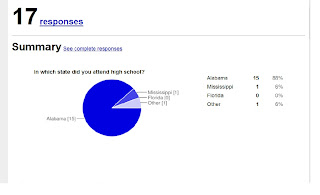Assignment: Read “What is the Purpose of Educational Technology?” by Jerrid Kruse: http://educatech.wordpress.com/2010/11/03/what-is-the-purpose-of-educational-technology/
Post your thoughts on stimulating versus engaging students.
Response:
Mr. Kruse’s article presents some interesting thoughts on using technology in the classroom. He did a study in one of his science classes to study the impact of providing students with a stimulating activity then testing them to see what they had learned. The result: although the students participated and enjoyed the stimulating activity, they were not actually engaged in what they were supposed to be learning. In reading through some of the comments on Mr. Kruse’s post, it is apparent that there are some educators who feel like they must use technology to get students’ attention. In this class – and others – we always talk about how students are so stimulated outside of the classroom that we have to incorporate technology into our classroom to compete with everything they are used to outside of the classroom. Educators must use technology appropriately to ensure that students are engaged and learning instead of just going through the motions.
Sunday, November 14, 2010
Wednesday, November 10, 2010
Project #6 Google Form
For my Google form, I asked some general questions about students’ background and student life at the University of South Alabama. Based on the responses, eighty-eight percent (fifteen out of seventeen) of those in my survey group attended high school in Alabama, and one person has attended college in a state other than Alabama. Sixteen out of seventeen people in my survey group decided to go to school at USA based on location. Fifty-three percent of students prefer in-class only instruction versus hybrid or online only classes.
Almost fifty percent of those in my survey group eat when they have a break between classes. No one in my survey group uses a bicycle for transportation around campus; sixty-five percent of them drive their personal vehicle. Over half of the students in my group have to plan their classes around a work schedule. Only forty-seven percent of those in my group have attended a Jaguars football game. I asked my group to rate their blogging skills since starting EDM 310. On a scale of one to five (one being still unsure about blogging and five being a pro), only one person rated themselves as a one.
Before this project, I had never used Google Forms before. Actually, I had never even heard of it. I was really impressed with how the information flowed right into the spreadsheet. This is a much more efficient than re-keying information into a spreadsheet manually.
Almost fifty percent of those in my survey group eat when they have a break between classes. No one in my survey group uses a bicycle for transportation around campus; sixty-five percent of them drive their personal vehicle. Over half of the students in my group have to plan their classes around a work schedule. Only forty-seven percent of those in my group have attended a Jaguars football game. I asked my group to rate their blogging skills since starting EDM 310. On a scale of one to five (one being still unsure about blogging and five being a pro), only one person rated themselves as a one.
Before this project, I had never used Google Forms before. Actually, I had never even heard of it. I was really impressed with how the information flowed right into the spreadsheet. This is a much more efficient than re-keying information into a spreadsheet manually.
Monday, November 8, 2010
Sunday, November 7, 2010
Summary Post C4K3 - C4K7
The student blogs that I read for C4K3 – C4K7 were all over the map in terms of content and quality. When thinking about this summary post for C4K, I kept Ms. Cassidy’s comments in mind that students might be more motivated to write for a global audience. That is obvious in the C4K3 and C4K7 blogs that I reviewed and commented on. These students seemed especially excited to be presenting “normal schoolwork” to a larger audience.
C4K3: I commented on a second grade student’s blog from Auckland, New Zealand. His blog post was a video of him reading a traditional New Zealand story.
C4K4: I commented on a fifth grade student’s blog from Sydney, Australia. Her blog post was about a vacation that she took with her family.
C4K5: I commented on a seventh grade student’s blog from Tasmania. Most of his posts were not academic related, and the post I commented on was on his creation of pivot animation and stop motion videos
C4K6: I commented on a sixth grade student’s blog from Iowa. This was a simple post on the type of books that the student liked to read.
C4K7: I commented on a second grade student’s blog from Australia. This was by far the best blog post that I have read from a student. The student’s response to my post reiterated how much the students enjoy our comments:
Dear Jared,
Thanks for the great comment! I have never had a person from an university before. Learning to be a teacher woulod be fun. I’m so happy you left me a comment for your study. Thanks for saying my writing skills are good and that you enjoyed looking at my pictures.
C4K3: I commented on a second grade student’s blog from Auckland, New Zealand. His blog post was a video of him reading a traditional New Zealand story.
C4K4: I commented on a fifth grade student’s blog from Sydney, Australia. Her blog post was about a vacation that she took with her family.
C4K5: I commented on a seventh grade student’s blog from Tasmania. Most of his posts were not academic related, and the post I commented on was on his creation of pivot animation and stop motion videos
C4K6: I commented on a sixth grade student’s blog from Iowa. This was a simple post on the type of books that the student liked to read.
C4K7: I commented on a second grade student’s blog from Australia. This was by far the best blog post that I have read from a student. The student’s response to my post reiterated how much the students enjoy our comments:
Dear Jared,
Thanks for the great comment! I have never had a person from an university before. Learning to be a teacher woulod be fun. I’m so happy you left me a comment for your study. Thanks for saying my writing skills are good and that you enjoyed looking at my pictures.
Saturday, November 6, 2010
C4T3 Summary
I was assigned Jerrid Kruse, who is an 8th grade science teacher in Nebraska. His blog presents some very interesting thoughts on technology in the classroom. The first blog post I commented on was titled “Technology lets you choose”. Mr. Kruse said that yes, technology lets you choose, but choose what? I commented that technology lets you choose, but you must be careful how you use it, and there is an increasing need to use technology responsibly – for educators and students.
Mr. Kruse’s response to me:
I would add something to your role of educators. In order for students to really use technology 'responsibly', they must be able to critique the technology. That is, student must be able to identify what things the technology is doing for them, how the technology might change their thinking, how the technology might change our culture, and how some of these changes are not desirable. All technologies have a faustian bargain, or a trade-off.
That said, these negative effects are not an excuse for teachers to not use technology. Tech literacy must include understanding how to use modern technology, but people rarely note how tech literacy must include understanding some of these deeper philosophical issues surrounding technology.
The second article that I commented on was “What is the purpose of educational technology?” Mr. Kruse presents some enlightening comments in this post as well. The part of his post that I could really relate to was when he was discussing stimulating students with technology without engaging them in the class. In this class – and others – we always talk about how students are so stimulated outside of the classroom that we have to incorporate technology into our classroom to compete with everything they are used to outside of the classroom. However, it is possible to stimulate the students without having them learn anything. I had not thought about this before, but it definitely has me thinking.
Wednesday, November 3, 2010
Blog Post #11
Ms. Cassidy’s First Grade class is quite technologically savvy. I was surprised to see how much the first graders could do. After listening to the interview with Ms. Cassidy, it made a little more sense that some of the students speaking on her video were out of the first grade. Regardless, it was enlightening to listen to their “tips” on how to successfully blog.
Ms. Cassidy’s comments on why students would want to write on a blog – with an audience versus writing on a piece of paper – with no audience were very interesting to me. I had not thought about this as a motivating factor for students to write, but it is really a good idea. It was also nice to hear that parents were so supportive of the idea. In today’s crazy world, teachers have to be creative and allow parents to be involved in ways that they are comfortable and ways that work with their schedules. Having parents support the use of technology is imperative in being successful with implementing it in the classroom.
It is nice that Ms. Cassidy has support from her Technology Coordinator. Based on our discussions in this class, not all teachers have the support from their principal or school board. That obviously makes a big difference in the success of implementing technology. It was also nice to hear Ms. Cassidy’s thoughts on Twitter. I too have been very reluctant with Twitter. These videos really encouraged me. It was nice to hear how Ms. Cassidy got started, and her tips for being successful with technology in the classroom.
Subscribe to:
Posts (Atom)


